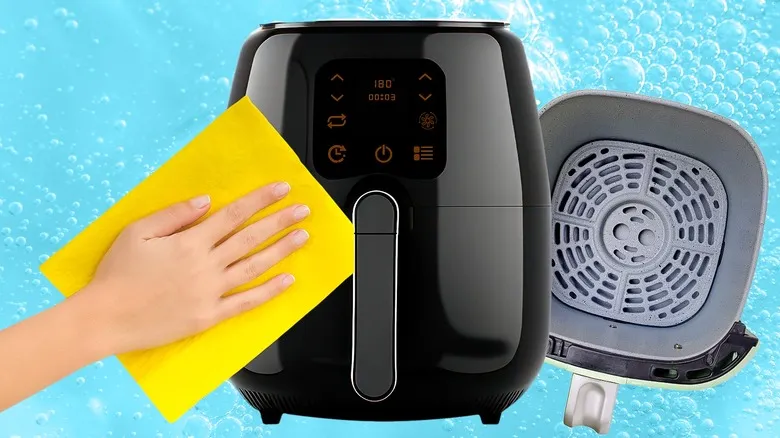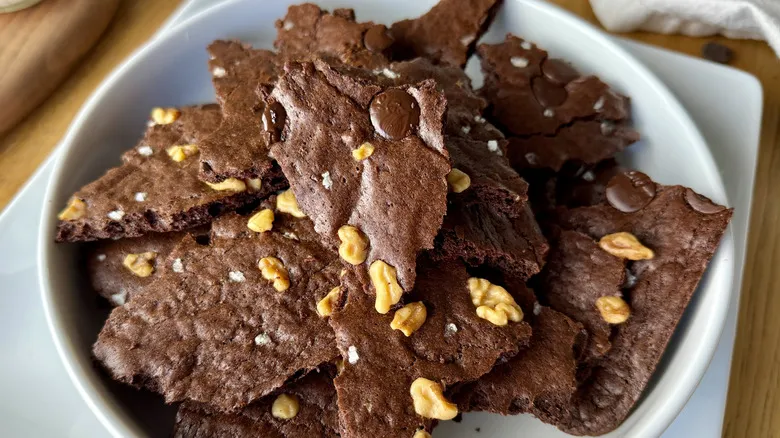Check the manual

It may seem basic, but it's essential to always consult the manuals for any appliances you purchase. These manuals provide guidance on how to use and maintain your items, along with important troubleshooting tips and helpful suggestions, such as the optimal placement of your air fryer in the kitchen. If you can't locate the manual for your air fryer, you can typically find it online by searching for the model number.
While each air fryer has its unique features, every manual will detail the various components of your appliance. Most air fryers, though not all, come with a food basket, a drawer or pan for grease collection, a heating element for cooking, a fan for hot air circulation, and external control buttons along with an air inlet. However, your specific air fryer may have additional components or may lack certain ones, like the drawer.
The manual will specify which parts of your air fryer are removable for cleaning and which are not. It will also provide the best cleaning methods, recommend how frequently to clean it, and offer tips to help prolong the lifespan of your appliance.
Understand that not all parts are dishwasher-safe
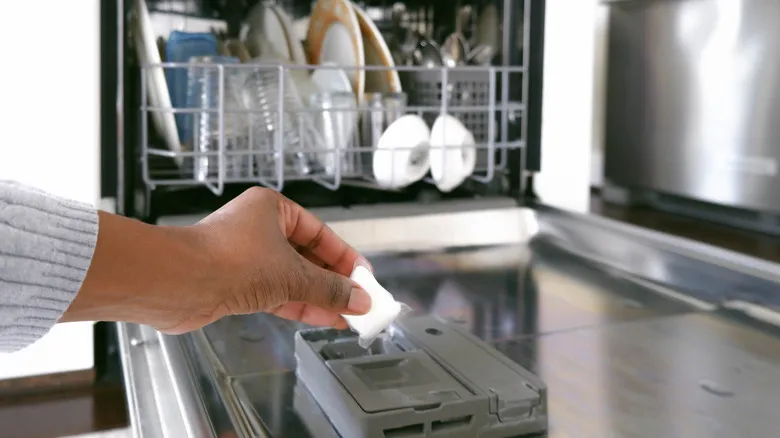
The dishwasher is undoubtedly the most convenient method for cleaning dishes and cookware. However, not all components of your air fryer are removable for dishwashing, and among those that are, not all are safe for the dishwasher. Your air fryer manual should specify which parts can be washed in the dishwasher. Look for a small symbol depicting two plates under a stream of water, which indicates that the parts are dishwasher-safe. Keep in mind that not all appliance components will have this symbol, even if they are suitable for dishwasher use.
In many air fryers, the basket is typically dishwasher-safe, and the grease drawer might be as well. Some manuals may advise placing these parts only on the top rack. Failing to adhere to these guidelines is a common error when loading the dishwasher, and placing air fryer components incorrectly can lead to damage.
Improper cleaning can result in issues such as a chipped coating or warping of your air fryer. If the basket becomes warped, it may not fit back into the appliance correctly. Additionally, certain plastics used in the drawer or tray may release harmful chemicals under the high heat of the dishwasher, potentially contaminating your dishes.
Clean the air fryer immediately after every use
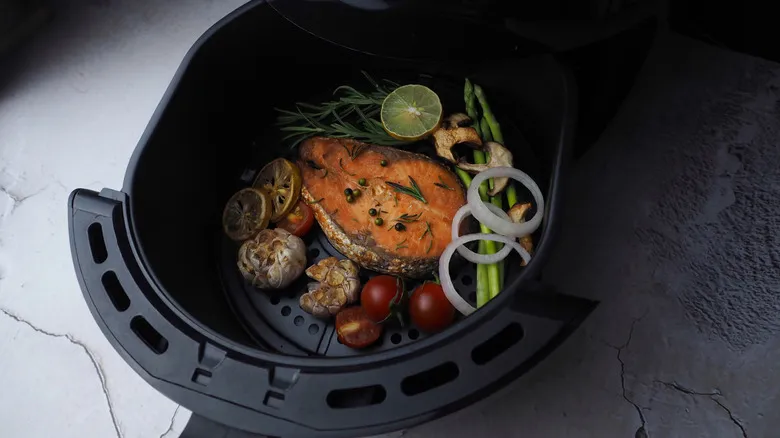
It might seem like a hassle, but it's important to clean your air fryer after each use. There are several reasons for this. Firstly, leaving grease or food residue on the air fryer components can lead to the growth of bacteria or mold, which could make you sick the next time you use it. Additionally, allowing residue to accumulate over multiple uses will make cleaning more challenging, potentially forcing you to use harsher cleaning methods that could damage the air fryer parts. Lastly, leftover food or grease poses a fire risk when you use the fryer again.
To avoid stubborn stains, clean your air fryer as soon as you can. While you enjoy your meal, let the air fryer cool down; never attempt to clean it while it's still warm. After it has cooled, remove the detachable parts, such as the basket and pan, and use a damp cloth to wipe the interior of the appliance. You can wash the removable parts in the dishwasher or by hand, ensuring they are completely dry before reassembling.
The exterior of the air fryer doesn't require frequent cleaning—this can be done as needed. The heating element or coils also don't need to be cleaned after every use, but it's a good idea to wipe them down every few uses.
Don't be afraid to let certain parts soak
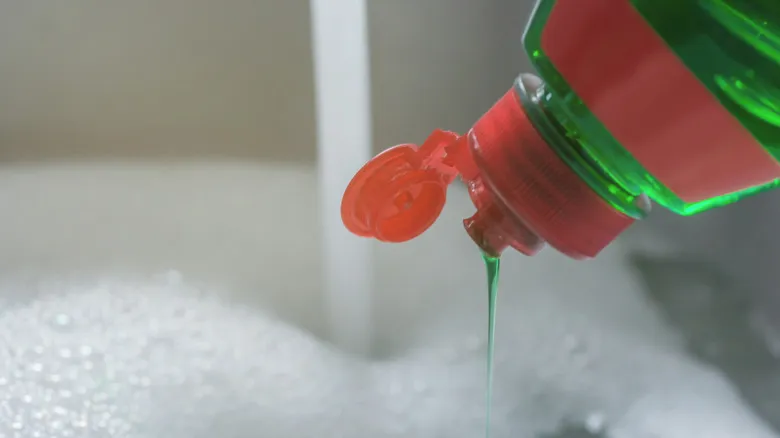
Some air fryer baskets are not dishwasher-safe due to their nonstick coating, which can be easily damaged. The upside is that this nonstick feature typically makes cleaning the baskets simpler. However, the downside is that if you encounter a stubborn stain, it can be challenging to find a safe method to remove it without harming the nonstick surface.
If you were raised by parents who assigned you the task of washing dishes every evening, you might have been told that soaking dishes was a sign of laziness. In reality, soaking can be quite effective for loosening stuck-on food. Allowing your air fryer basket or pan to soak in a warm soapy bath can help soften tough stains, making it easier to wipe away food residue, minimizing damage to your air fryer components, and preserving the nonstick coating. The soaking time will vary based on how stubborn the residue is, but you can typically check the basket or pan after about 10 to 15 minutes.
Use baking soda and vinegar for stubborn stains
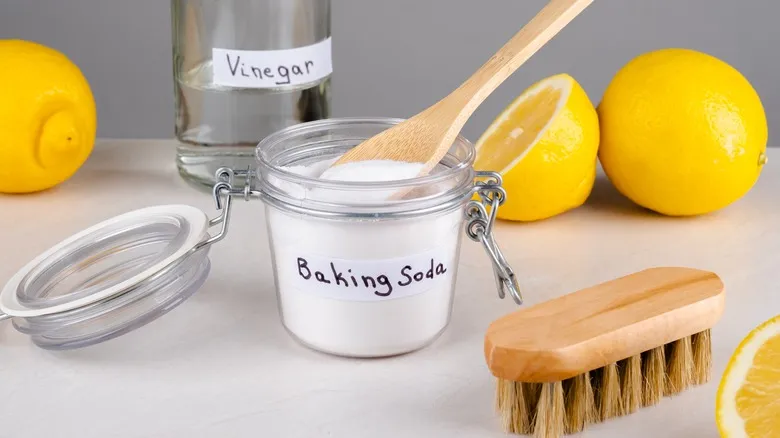
It's the classic science experiment: a paper mache volcano paired with a blend of baking soda and vinegar to produce a fizzy, bubbling eruption. However, the baking soda and vinegar mixture serves a purpose beyond just entertaining; it’s also a fantastic stain remover.
On their own, both baking soda and vinegar are effective cleaning agents. Baking soda is great for breaking down grease and acts as a mild abrasive, while vinegar excels at dissolving mineral deposits. When combined, they become even more powerful, effectively tackling stubborn, stuck-on food and stains. Vinegar is acidic, and baking soda is alkaline. When these two are mixed, a chemical reaction occurs that releases carbon dioxide, creating the bubbles you observe. These bubbles are excellent for loosening grime and food residue without risking damage to your cookware.
To use this method, sprinkle some baking soda over the area you wish to clean, then spray or pour a small amount of vinegar on top. Allow the two substances to work together, then wipe the area with a cloth or sponge and rinse. Baking soda is typically gentle enough not to harm nonstick surfaces, but if you're worried, you can use a bit more vinegar or rinse the area first before wiping it down.
Avoid harsh chemicals or abrasive sponges

As we've pointed out several times, it's important to steer clear of harsh or abrasive materials when cleaning your air fryer. Using rough sponges or steel wool can harm the basket or tray, while strong chemicals can degrade the protective coating. This not only creates an unattractive appearance, but it can also compromise the nonstick surface, making your basket less effective.
When the enamel gets damaged, food tends to stick in those areas, making cleaning more difficult and prompting the use of harsher stain removal methods. Additionally, a breach in the coating can accelerate its deterioration, resulting in even more effort during cleanup. It's worth noting that cleaning solutions aren't the only culprits; using nonstick sprays on nonstick pans can also harm the coating.
While it's generally recommended to avoid abrasive materials on the removable components of your air fryer to maintain its functionality, you should never use abrasives on the heating element. Doing so can cause significant damage, creating a fire hazard that is typically not covered by warranty.
Clean the inner compartments also
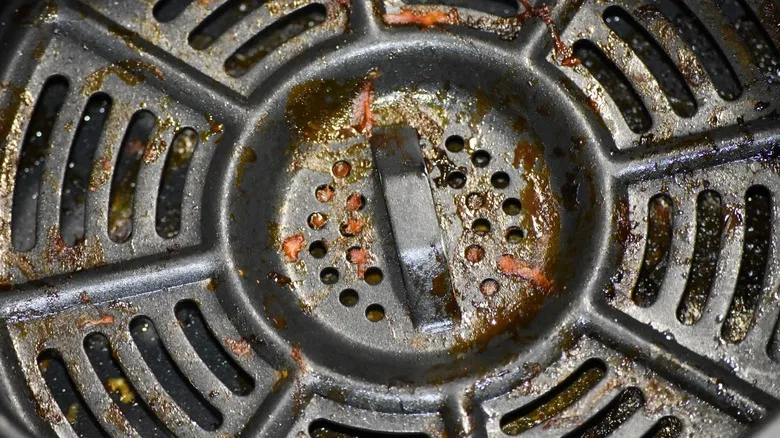
We've previously discussed the importance of cleaning the interior of your air fryer; this isn't just a suggestion—it's essential. It's completely normal to feel hesitant about the cleaning process. Given the electrical components inside, you probably want to avoid any risk of damaging the appliance or injuring yourself.
Naturally, you should never immerse your entire air fryer in water. It is, after all, an electronic device, and exposing certain parts to water can lead to serious damage. Instead, once the air fryer has cooled down and you've removed the basket, tray, and any other detachable parts, take a soft cloth and dip it in hot, soapy water. Wring out most of the excess water and gently wipe down the interior surfaces, being careful around the heating coils.
If you find food or grease stuck to the heating element, a soft-bristled brush, such as a toothbrush, can usually help remove it. Avoid using anything overly abrasive, like steel wool or wire brushes, as this could damage the coils and create a fire risk.
Make sure the air fryer is dry before using it again
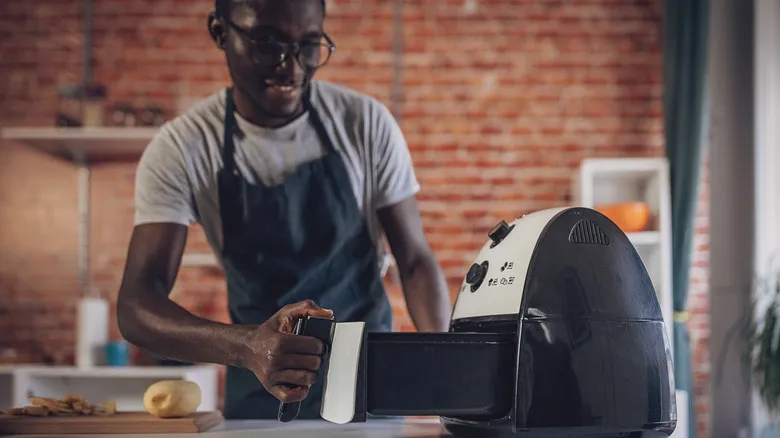
Recently, a cleaning hack for air fryers went viral on TikTok and YouTube, suggesting that adding water to the air fryer and turning it on would create steam to help loosen stuck food for easier cleaning. However, this method is not advisable.
While a tiny amount of water may not harm your air fryer, if it seeps into the electrical components, it could cause significant damage. Air fryers are not intended for heating water, and it's best to keep any liquids away from the appliance. In addition to the risk of damaging the electronics, heated water can splatter or spill, leading to burns or other injuries. There's also a danger of electric shock. Instead of trying out these trendy TikTok hacks, it's safer to follow the cleaning instructions provided in your user manual.
Use parchment paper or liners for even easier clean-up
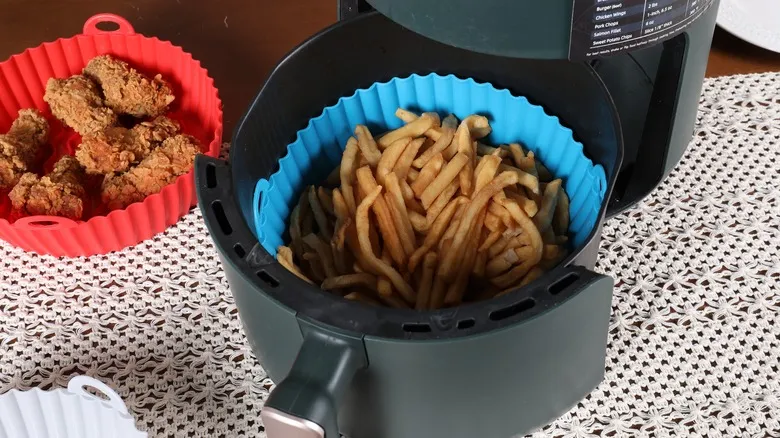
If you’re anything like us, you probably dread doing the dishes. Parchment paper can be a game changer in this situation, especially since, as we noted, nonstick spray isn’t recommended for your appliance. Parchment paper is often used to line various baking sheets and pans, and once you’re finished cooking, you can simply toss it away along with the mess. There are also plenty of other clever uses for parchment paper in cooking, including — surprise! — lining the basket of your air fryer. Just cut the paper to the right size, place it in the basket, and then add the food you want to fry.
Many companies also offer air fryer liners, which can be made from silicone or parchment-like material that’s pre-cut to fit perfectly in the air fryer basket. Some brands even feature small holes in their liners to enhance airflow, ensuring that your food cooks evenly and gets nice and crispy, even with the liner in place. You can use parchment paper or liners whenever you use the air fryer, but they’re particularly useful for messy or greasy items, as well as for some unexpected foods.
Recommended
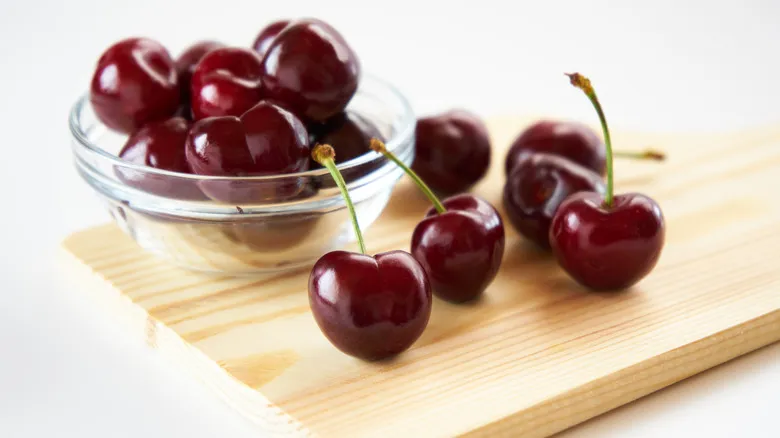
Effortlessly Pit Cherries In A Flash With A Genius Chopstick Hack
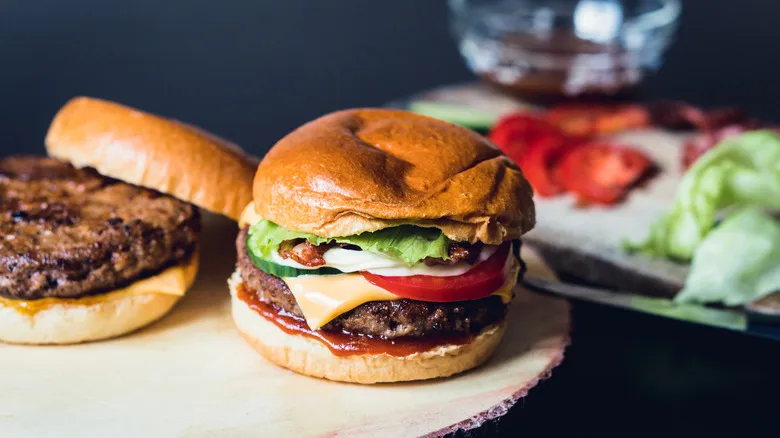
The Air Fryer Is Your Answer For Fuss-Free Burgers

You Think You Don't Need Fondue Forks, But Here's Why You Do
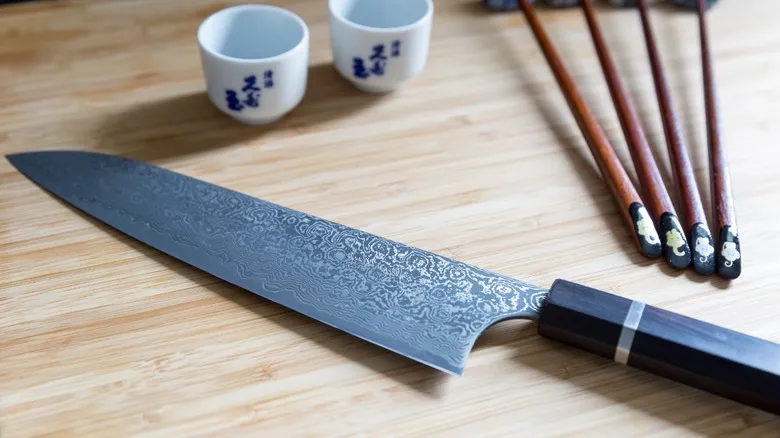
Why Are Japanese Knives So Expensive?
Next up

